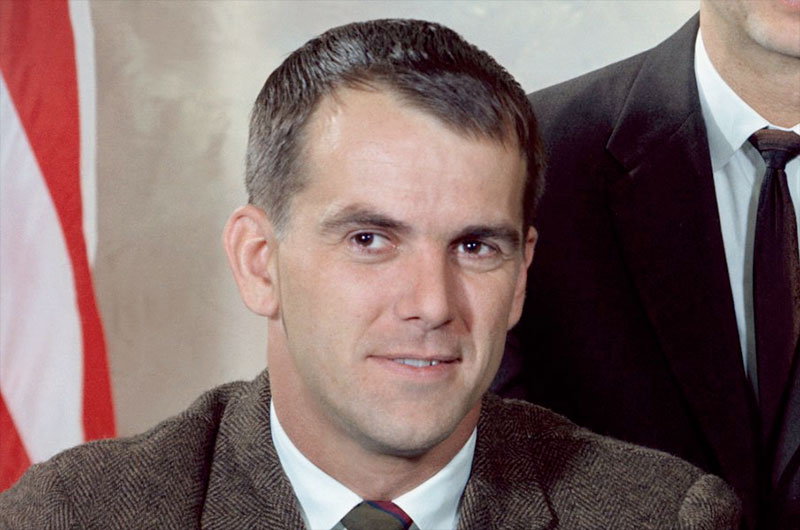Curt Michel, Scientist-Astronaut Who Left NASA After Losing the Moon, Dies at 80

Curt Michel, an astrophysicist who was among NASA's first scientist-astronauts but who resigned when it became clear he would not fly to the moon, died on Feb. 23. He was 80.
Curt Michel's death was reported on Friday (Feb. 27) by Rice University in Houston, where served as a faculty member before and after his time with NASA.
"Although he retired in 2000 after 37 years at Rice, Michel continued to keep an office on campus, where he pursued his studies of solar winds [and] radio pulsars," stated the university in a press release.
Michel was an assistant professor for space science at Rice when he was selected with NASA's fourth group of astronauts in June 1965. Chosen together with five other scientists, Michel and his fellow trainees – Owen Garriott, Ed Gibson, Duane Graveline, Joseph Kerwin and Harrison Schmitt – were the first astronauts to be recruited for their academic backgrounds, rather than their flight experience.
"When we were selected at the urging of the National Academy, the idea was they wanted scientists to be sent to the moon," Michel told a Rice interviewer in 2009. "But when we got in, the astronaut office's idea was to use the scientists after the lunar missions." [NASA's 17 Apollo Missions in Pictures]
Though they underwent the same survival, endurance and geological training that the moon-bound astronauts were going through, Michel and the other scientist-astronauts were assigned to projects that were part of the post-lunar landings Apollo Applications Program (AAP), including the first U.S. space station Skylab and the Apollo Telescope Mount (ATM), the solar observatory being designed for the orbiting outpost.
"Newsmen asked us why we wanted to go the moon," Michel wrote in a journal at the time, as excerpted in the book "NASA's Scientist-Astronauts" by David Shayler and Colin Burgess. "Everyone evidently thought of us as going on a lunar landing mission, except the Astronaut Office, which kept a discreet silence beyond letting it be known that the first three landing missions would be manned by regulars."
Breaking space news, the latest updates on rocket launches, skywatching events and more!
Despite an interest in the ATM solar studies, Michel found that the training and other NASA projects associated with being an astronaut were limiting the time for his research. In 1968, just three years after joining the program, Michel took a year-long leave of absence to resume his studies into radio pulsars and numerical methods at Rice.
Deciding his chances for a moon flight were low and with fewer seats available on the later Skylab missions, Michel resigned from the astronaut corps one week before Apollo 11 accomplished the first lunar landing on July 20, 1969. His final activities as a NASA astronaut were to attend a Presidential dinner celebrating the Apollo 11 crew and to take part in Neil Armstrong's, Buzz Aldrin's and Michael Collins' post-flight debriefings.
Michel may have also made one other contribution to the Apollo program: advancing the appointment of his fellow scientist-astronaut Harrison "Jack" Schmitt to the Apollo 17 mission.
"The National Academy of Sciences got all pushed out of shape when I left," Michel said in 2009. "I think that was largely influential in Jack getting his flight. When it looked like their primary idea of getting a scientist to the moon was going to flop, they finally started pushing their weight around."
Schmitt replaced pilot Joe Engle on the final moon landing and became the only geologist to explore the lunar surface firsthand in December 1972.
Michel retired from NASA on Aug. 4, 1969, having never flown in space.
Frank Curtis "Curt" Michel was born on June 5, 1934 in La Crosse, Wisconsin. He joined the U.S. Air Force in 1955, logging 500 hours primarily flying F-86D interceptors in the states, as well as England and Germany during his three years of active duty service.
Michel received his bachelor's and doctorate degrees in 1955 and 1962, respectively, at the California Institute of Technology, where he studied with Nobel Prize laureates Richard Feynman and William Fowler. He was a research fellow at Caltech when he was recruited for Rice's first-in-the-nation space science department in 1963. He chaired the department from 1974 to 1979.
As a Guggenheim fellow, Michel spent 1979 to 1980 in France and as a Humboldt fellow, a year in Germany from 1983 to 1984. He also spent a year in Japan at the Solar-Terrestrial Environment Lab of the University of Nagoya as a visiting professor in 2001-2002.
Michel's astrophysics research focused primarily on radio pulsars, or rapidly rotating magnetized neutron stars, from their discovery in 1967 through the course of his career. He wrote a book on the subject, "Theory of Neutron Star Magnetospheres" (University of Chicago Press, 1991).
Michel is survived by his wife, Bonnie Hausman, and their two children, Alice and Jeff.
Follow collectSPACE.com on Facebook and on Twitter at @collectSPACE. Copyright 2015 collectSPACE.com. All rights reserved.

Robert Pearlman is a space historian, journalist and the founder and editor of collectSPACE.com, a daily news publication and community devoted to space history with a particular focus on how and where space exploration intersects with pop culture. Pearlman is also a contributing writer for Space.com and co-author of "Space Stations: The Art, Science, and Reality of Working in Space” published by Smithsonian Books in 2018.
In 2009, he was inducted into the U.S. Space Camp Hall of Fame in Huntsville, Alabama. In 2021, he was honored by the American Astronautical Society with the Ordway Award for Sustained Excellence in Spaceflight History. In 2023, the National Space Club Florida Committee recognized Pearlman with the Kolcum News and Communications Award for excellence in telling the space story along the Space Coast and throughout the world.

